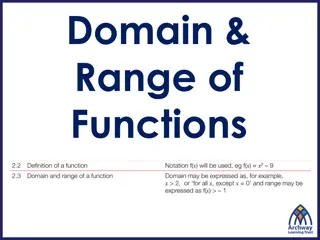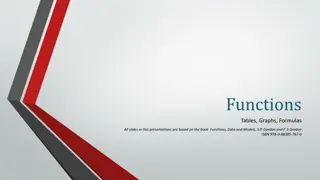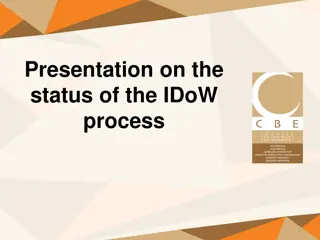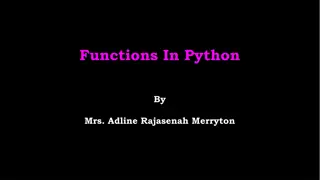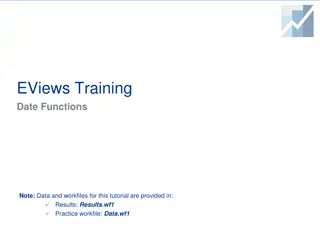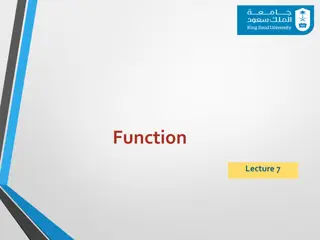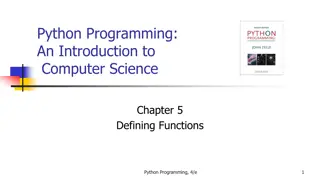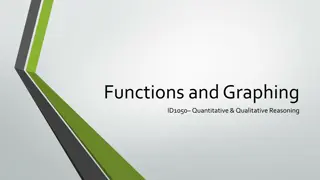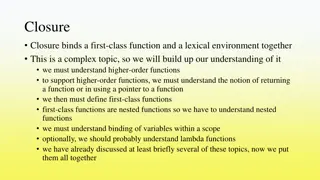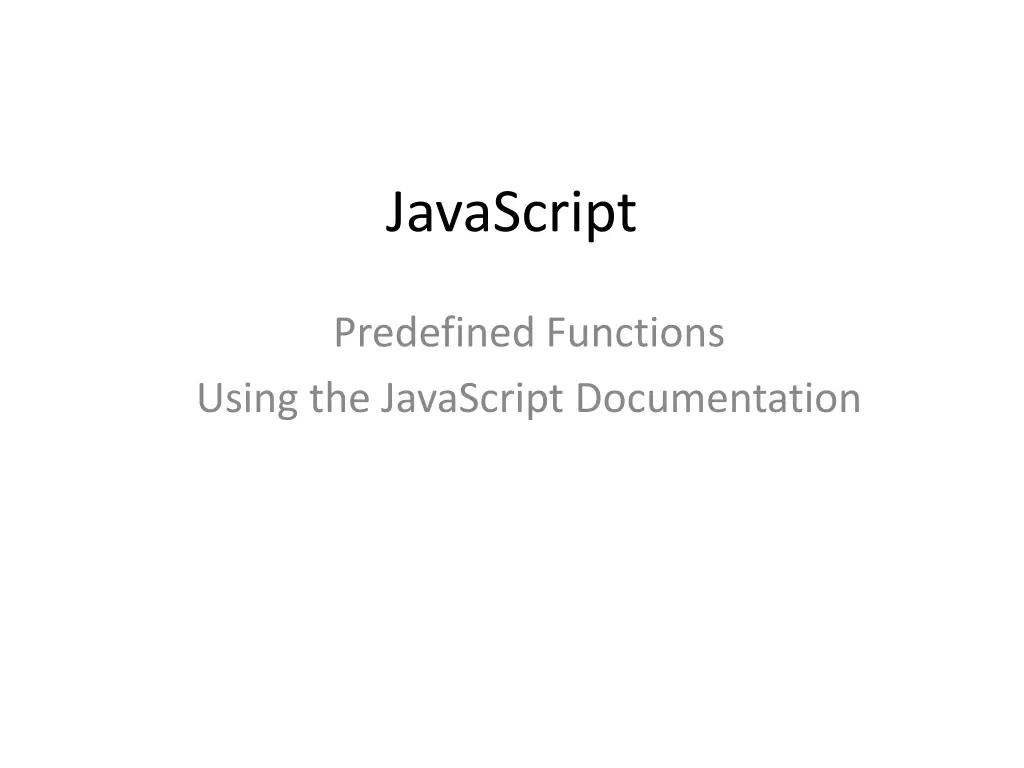
Understanding Predefined Functions in JavaScript Documentation
Explore the difference between user-defined and predefined functions in JavaScript, learn how to navigate and utilize the documentation for predefined functions such as Date and Math classes, and discover resources to enhance your understanding of built-in functions.
Download Presentation

Please find below an Image/Link to download the presentation.
The content on the website is provided AS IS for your information and personal use only. It may not be sold, licensed, or shared on other websites without obtaining consent from the author. If you encounter any issues during the download, it is possible that the publisher has removed the file from their server.
You are allowed to download the files provided on this website for personal or commercial use, subject to the condition that they are used lawfully. All files are the property of their respective owners.
The content on the website is provided AS IS for your information and personal use only. It may not be sold, licensed, or shared on other websites without obtaining consent from the author.
E N D
Presentation Transcript
JavaScript Predefined Functions Using the JavaScript Documentation
Learning Objectives By the end of this lecture, you should be able to: Understand the difference between "user-defined" functions and "predefined" (a.k.a. 'built-in') functions Understand how to look up and investigate the documentation for predefined JavaScript functions Be able to comfortably work with built-in functions, especially: The functions in the Date class The functions in the Math class Math.random() Math.sqrt() Be able to look up and apply other functions in this class The toFixed() function
'Predefined' (aka 'Built-In) Functions Think back to the user-defined functions we have been creating. For example: function greetUser() { alert("Hello"); } In addition to the infinite variety of user-defined functions that we could write ourselves, JavaScript also comes with many, many 'built-in' or predefined functions. The parseInt() and parseFloat() functions are examples of such built-in functions. Predefined functions are written by the creators of a programming language in order to solve many common or anticipated coding situations that may arise. For example, the people who created JavaScript recognized that programmers would quite likely need to access the date or time in their code, or that they would need to do various mathematical operations. For this reason, the creators wrote a series of predefined functions to accomplish these tasks. We have seen and used several predefined functions already. Examples include: alert() getElementById() Date() Math.sqrt() parseInt() parseFloat() toFixed() 3
How do I learn about these predefined functions? As you learn more about a given programming language, you will encounter many of these functions. In addition, every language out there makes its documentation available online. Programmers often refer to references that describe a language s built-in functions and other tools as the docs . For example, you can find JavaScript documentation all over the web. The Mozilla Developer's Network (MDN) and has a very good set of JavaScript documentation, as does W3 Schools. One great way to learn about the various functions available to you is to simply explore the docs on websites such as these. Don't be discouraged if you look something up in the docs and find that much of it makes no sense. This is very typical for people who are still early in their programming careers. Over time you will become more and more proficient at interpreting them. For the time being, try to focus on picking out the parts that do make sense to you. As another learning tool, docs often contain examples which are often one of the best ways to get the hang of how a function works. 4
Example: Predefined functions in the Math class Here is a partial screen capture from the MDN documentation showing some of the predefined functions that allow us to do various mathematical calculations. 5
Example: Predefined functions in the Math class Clicking on the Math.sqrt(x) function brings us to this page: 6
The Math.random()function Math.random() returns a random number between 0 and 0.9999999 (i.e. a value just below 1). This may not seem all that useful at first glance. However, with a little bit of coding magic, we can make this seemingly pointless function do some very useful things. For example, suppose you wanted to simulate a random roll of a dice. To do so, you would want to randomly generate a random number between 1 and 6. Here is how we would use the Math.random() function to do so: The following line of code: (Math.random()*6) + 1; Will generate a random number between 1 and 6.99999 You can replace the number 6 with any other number you like. For example, if you replace it with a 10, you would get a random integer number between 1 and 10.99999 All of the parentheses are necessary var diceRoll = (Math.random()*6)+1; //The random() function includes decimals, //so we must remove the them: diceRoll = parseInt(diceRoll); alert("You rolled a: " + diceRoll);
The Math.random()function We will likely be using this random() function several times. Whenever you know that you are going to use a function frequently, it is well worth the time to study the documentation to really get a sense of how it works. Here is a partial screen grab from Mozilla s JavaScript documentation:
The Math.random()function As you can see, the documentation can be a bit confusing if you are new to programming. Over time, more and more of it will make sense. However, even novice programmers can usually make sense of straight-forward functions. (Some highly specialized functions are only meant to be used in certain contexts.) I will provide my own summary of Math.random() here: The function returns a numeric value up to several decimal places. The value ranges from a low of 0, to a high of just below (but not including) 1. i.e. Between 0 and 0.99999999. While the number is somewhat random, if there are some highly sensitive (e.g. cybersecure) situations in which you want a truly random number, you should not use this function. As we have also discussed, often, the best way to see how a function works is to look at examples. Let s do so now: var random = (Math.random()*10)+1; //all of the parentheses are required random = parseInt(random); //remove the decimals alert("A random number between 1 and 10: " + random); The number 10 in the example above can be replaced by any integer number. In that case, random will be set to a random value between 1 and the number you chose. For example, (Math.random()*7)+1 will generate a random float number between 1.0 and 7.999999.
File: die_roll.html <!DOCTYPE html> <html lang="en"> <head> <meta charset="utf-8"> <title>Dice Roller</title> </head> <body> <h1>Dice Roll Game</h1> <button type="button" onclick="dieRoll()">Roll the Die!</button> <div id="results"></div><!-- end of results div --> <script> function dieRoll() { var die1, die2; var resultsString; die1 = (Math.random()*6)+1; //die1 holds a float between 1.0 and 6.9999 die2 = (Math.random()*6)+1; die1 = parseInt(die1); die2 = parseInt(die2); resultsString = "Your first die was a " + die1 + ", and your second die was a " + die2 + "."; document.getElementById("results").innerHTML = resultsString; } </script> </body> </html> dieRoll() function. So each time you click, you will see the results of a new roll of the die. You do not need to refresh the page. NOTE: Every time you click the button, you are re-invoking the 10
The Date object We haven't discussed "objects" as that is beyond the scope of this course. However, try to follow along with this example and the ones on the upcoming slide(s): var today = new Date(); The variable 'today' is an object that holds all kinds of information about the current date including the current hour, minute, second, month, day of the month, year, etc. If we were to output the today variable like so: alert(today); we would get something like the following:
The Date object Given the today object as shown below: var today = new Date(); We can invoke various Date() functions using our today variable like so: currentYear = today.getFullYear(); //currentYear holds the current year, e.g. 2021 currentHour = today.getHours(); //currentHour holds the hour as a number between 0 and 23 alert("The current year is: " + currentYear); We have just discussed a couple of the functions that you can invoke on a Date() object. There are several other useful functions such as getMinutes(), getSeconds(), etc. etc. Pop-Quiz: How do you find out about other Date() functions that are available to you? Answer: You look it up in the documentation! Practice by looking up the documentation and trying out some of the other Date() functions.
Checking for NaN (Not a Number) Recall that if JavaScript expects a number and does not get one, it will return the error: NaN For example: alert( parseInt("hello") ); There is a useful predefined JavaScript function that allows you to test for this particular error: isNaN() var age = document.getElementById('txtAge').value; age = parseInt(age); if ( isNaN(age) ) alert("Please enter a valid age."); else alert("You are " + age + " years old!"); File: nan_test.html
The toFixed() function This useful function allows you to specify the number of decimal places displayed by a numeric value in a variable: var number = 26.666666666667; alert( number ); number = number.toFixed(2); alert(number);
Explore! The best way to get acquainted with the various objects and functions available to you is simply to explore the documentation. As mentioned earlier, don t get discouraged if most of what you see / read in the docs looks unfamiliar and is confusing. This is entirely normal when you are new to a programming language. Over time you will come to understand more and more of it. For now, be sure to practice and experiment by playing around with the various functions from the Math and Date classes. Be sure to look at the examples provided by the documentation as they can really help give an idea of how things work. Perhaps the two best sites for JavaScript documentation are MDN (Mozilla Developer Network) and W3 Schools. Here is a screen capture showing the overview JavaScript reference page from W3 Schools: 15




